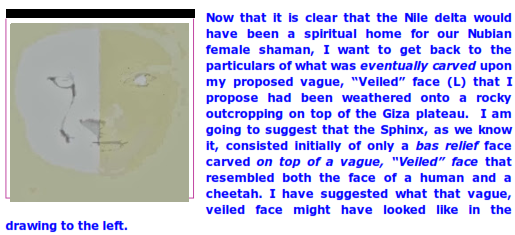The "Veiled" Face at Giza and the Carving of the Sphinx Face

It was undoubtedly less symmetrical and less detailed, just enough to suggest a human/cheetah face. I have added the split coloring to help you see both halves. You may want to enlarge the image to see both halves more clearly because I purposely made them very vague. I have been suggesting that the carving of the Sphinx face took place somewhere around 6000 B.C.. However, as I've said before, there is no way of really knowing if it was done in 6000 B.C., or 5000 B.C., or 4000 B.C., or some date in between, as the preliterate cultural and artistic forces governing the characteristics of the carving would have been the same for all of these dates. At this stage, however, I am going to go with my earlier proposition that it took place in 6000 B.C. because of the following:



b) Some will argue that the large amount of time that I propose separated the phases of carving would have made any communication between the carvers in each phase extremely difficult, as there was no writing, and therefore no written records to pass down explaining what the Sphinx was all about.
I will answer both objections in the sections that follow.
Author's Note
As I mentioned earlier, I am open to the fact that there may have been other great events that occurred in preliterate Egypt (6000-3200 B.C.) of which I am not aware. In that case, the various arguments I have presented (and will present) for the creation of the Sphinx in phases would still be valid. What would differ is that the time spans between phases would be much smaller.
End Author's Note







